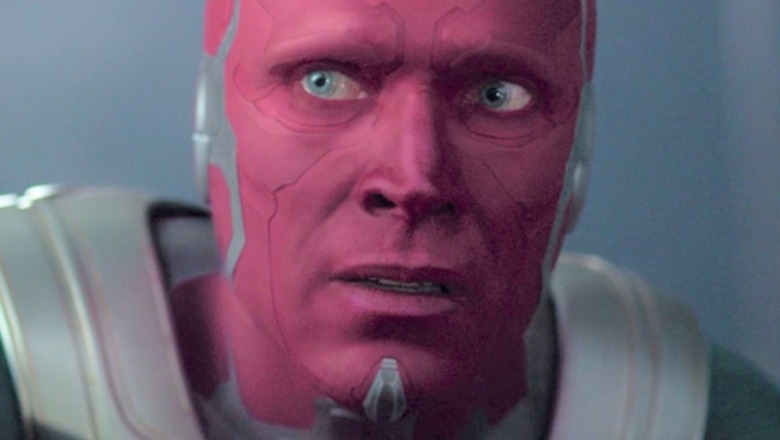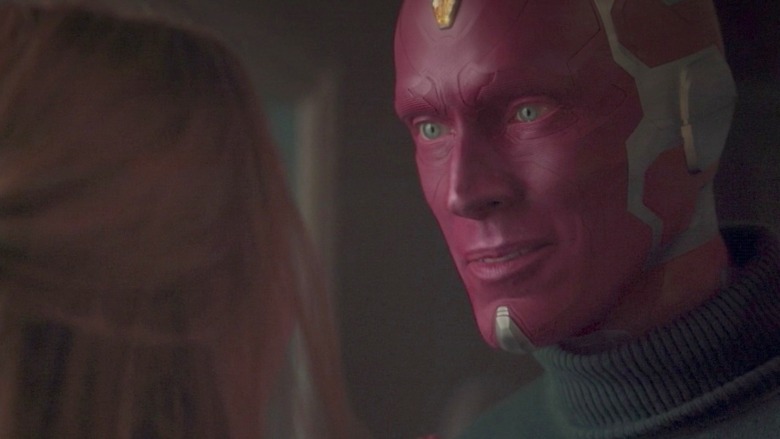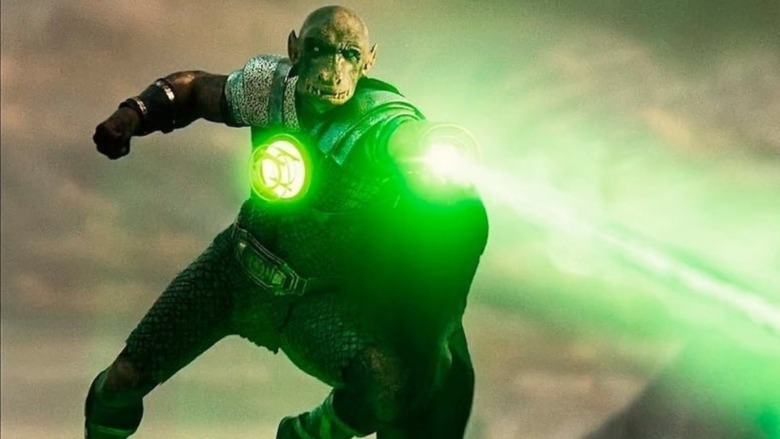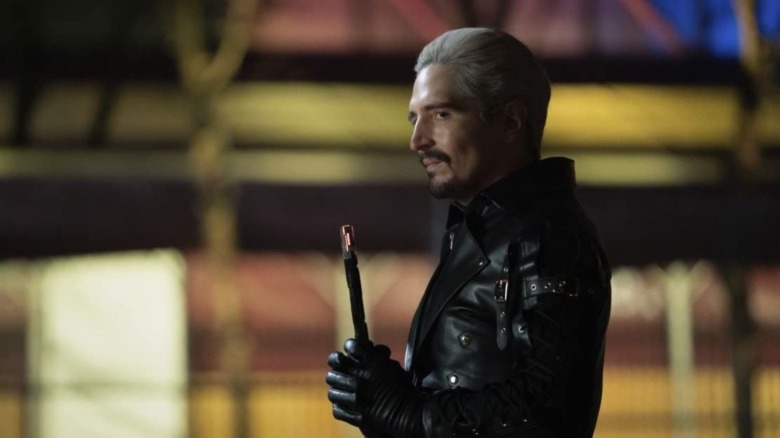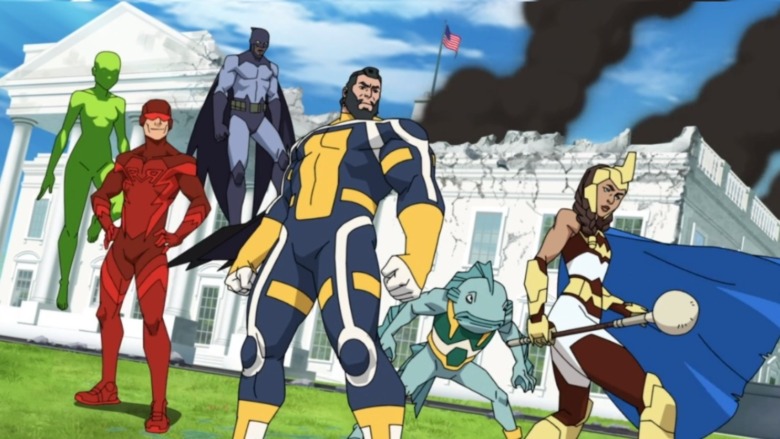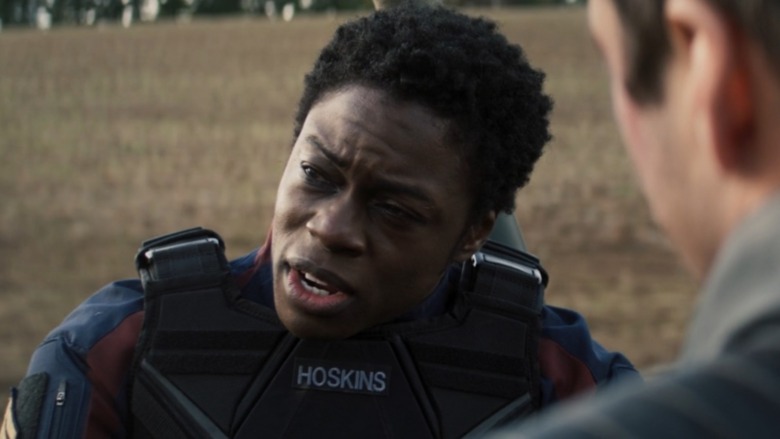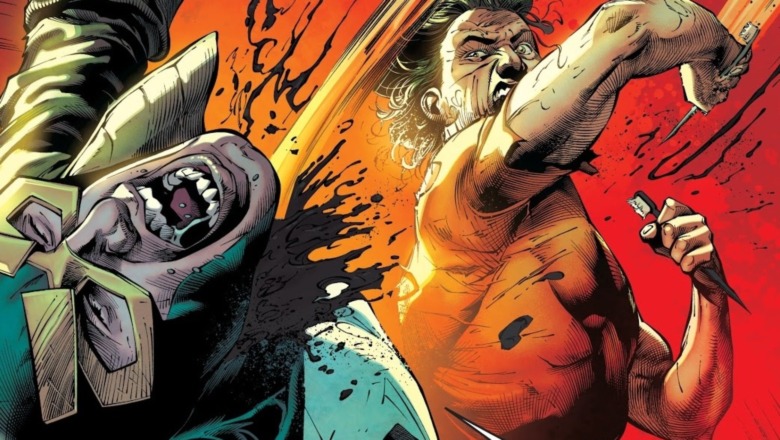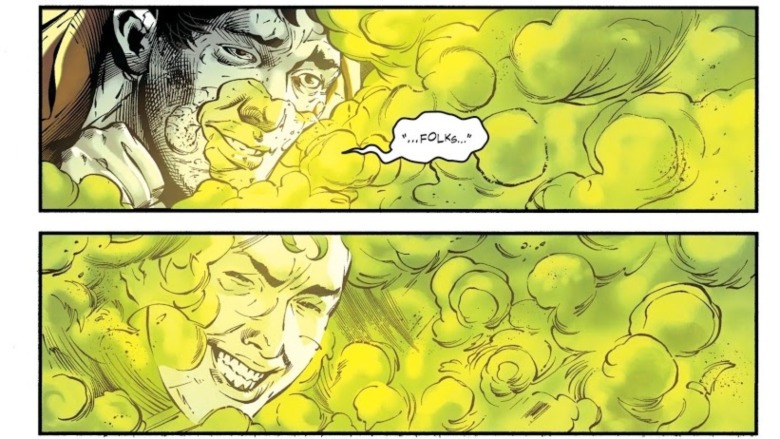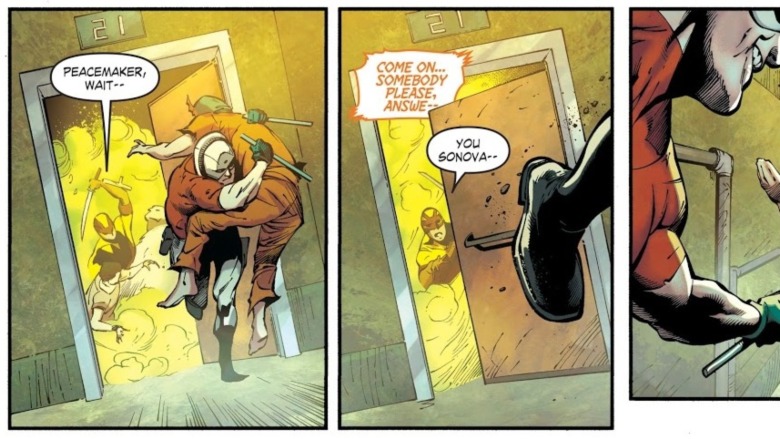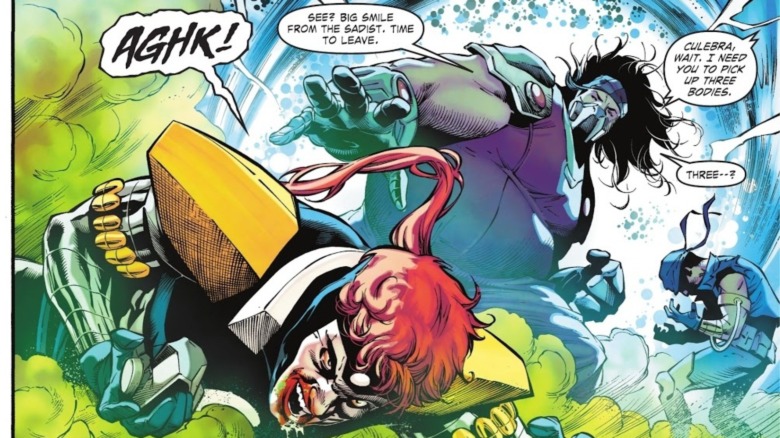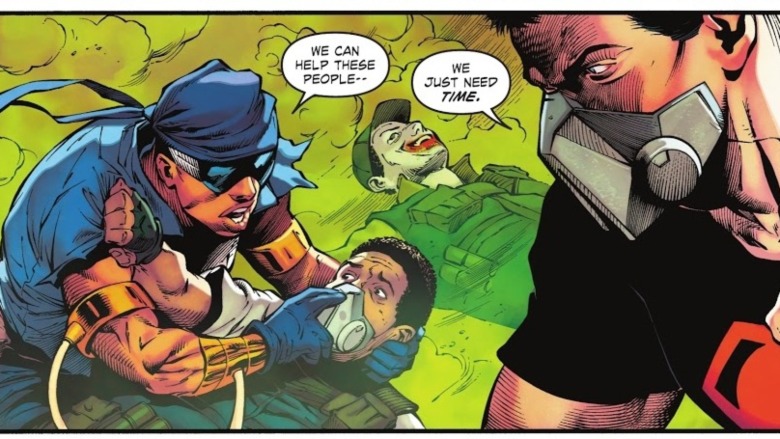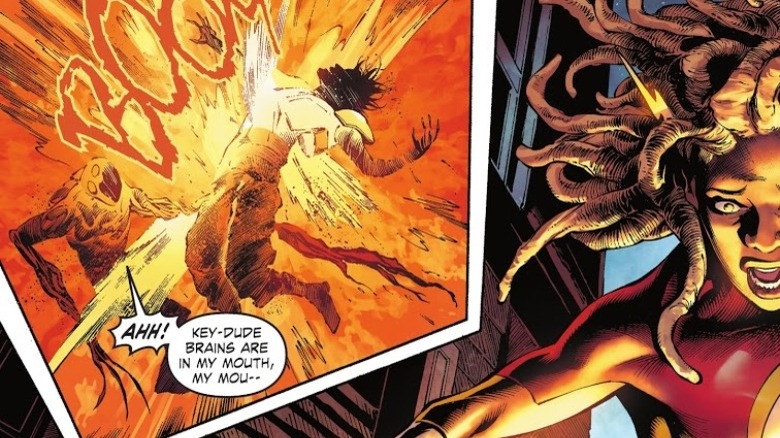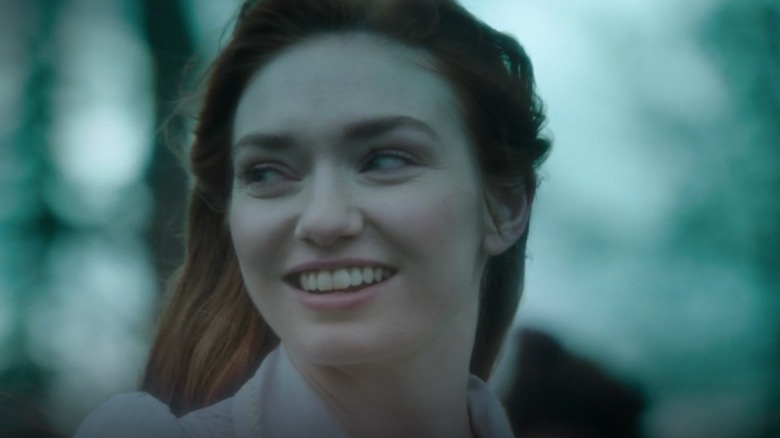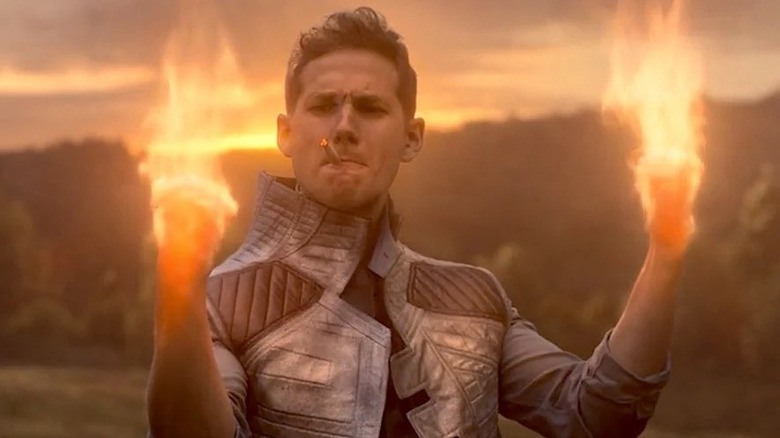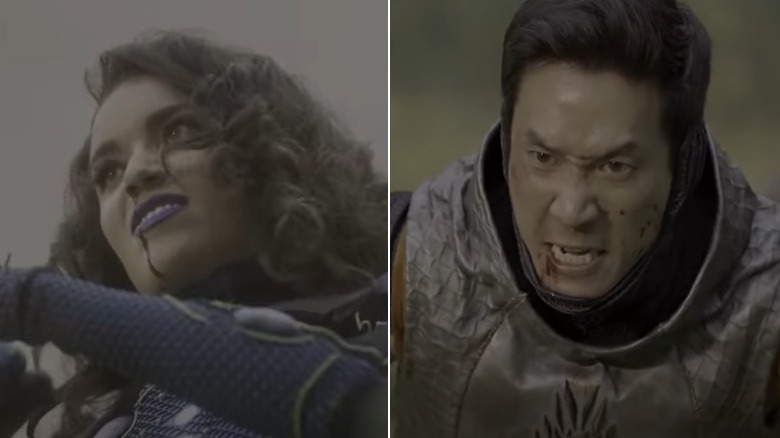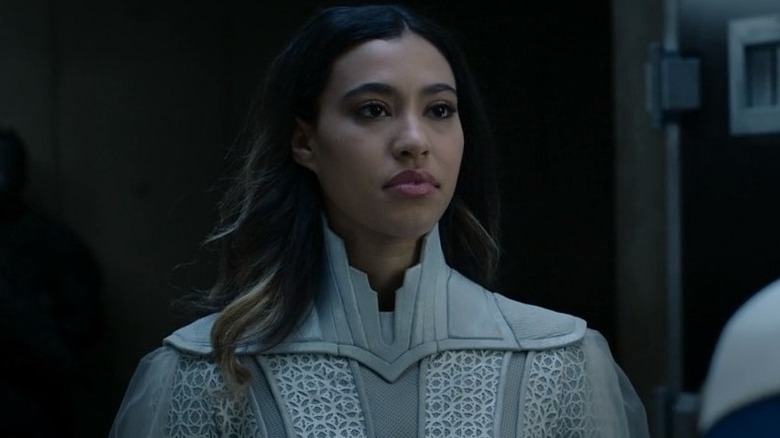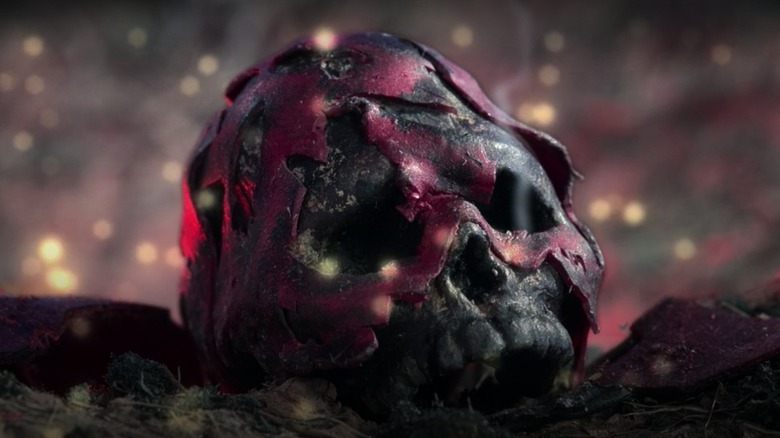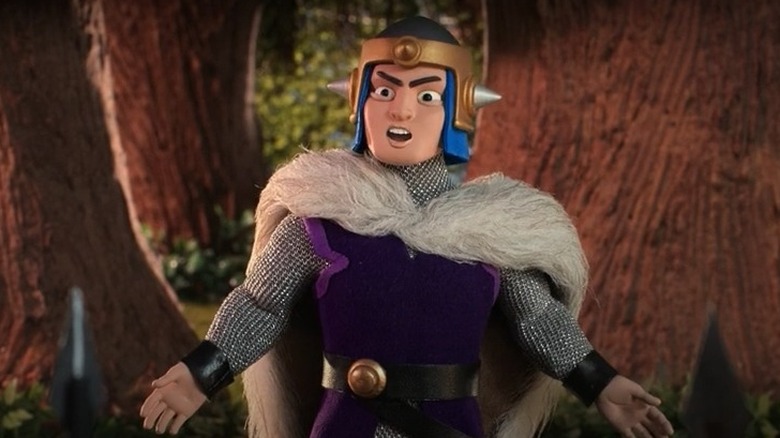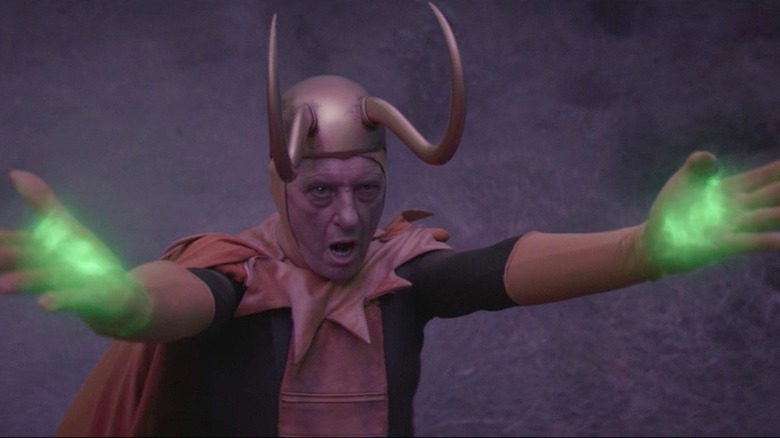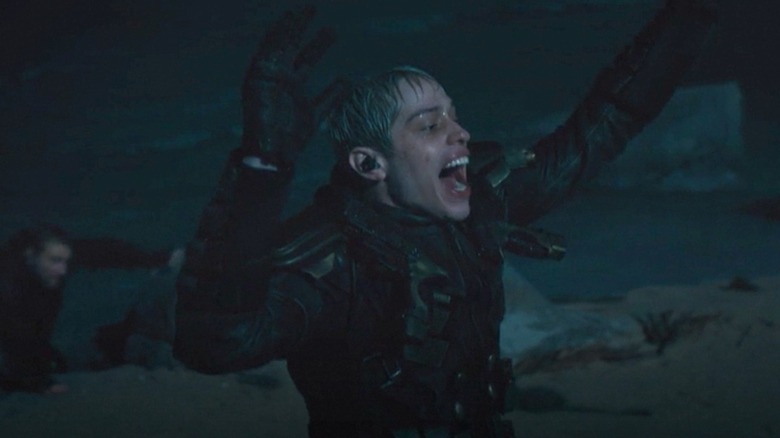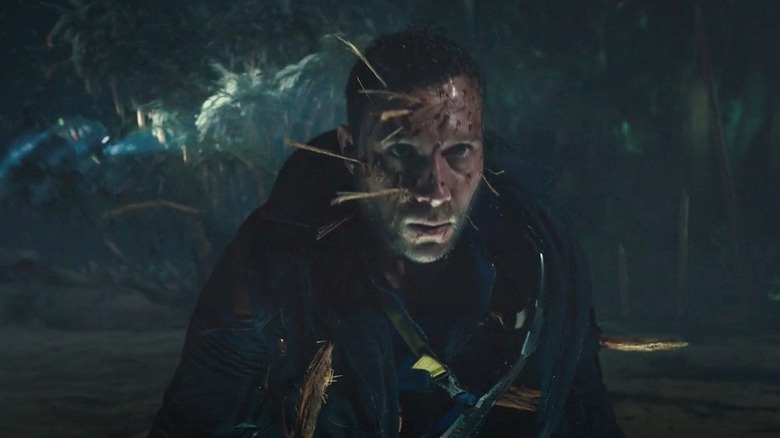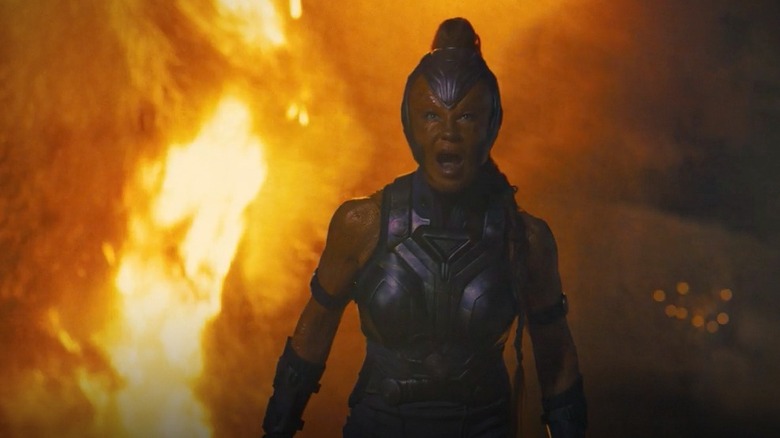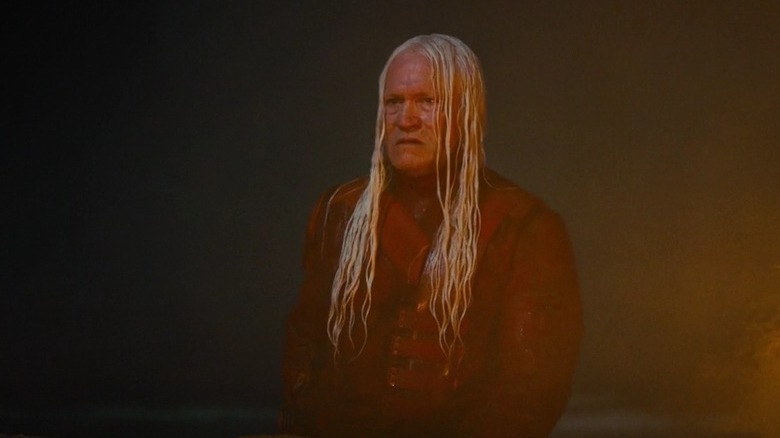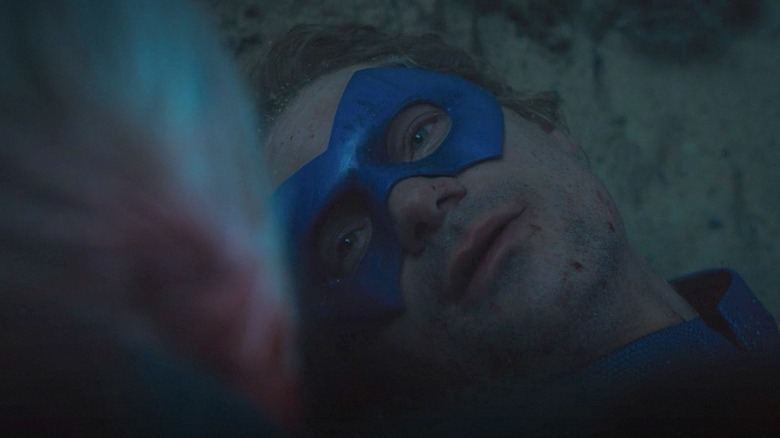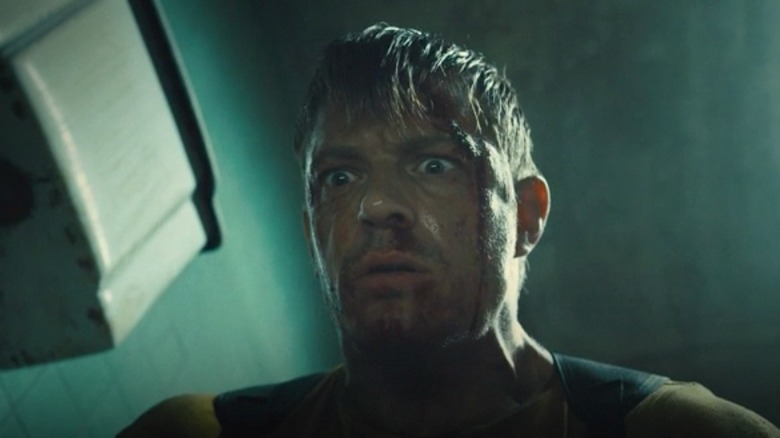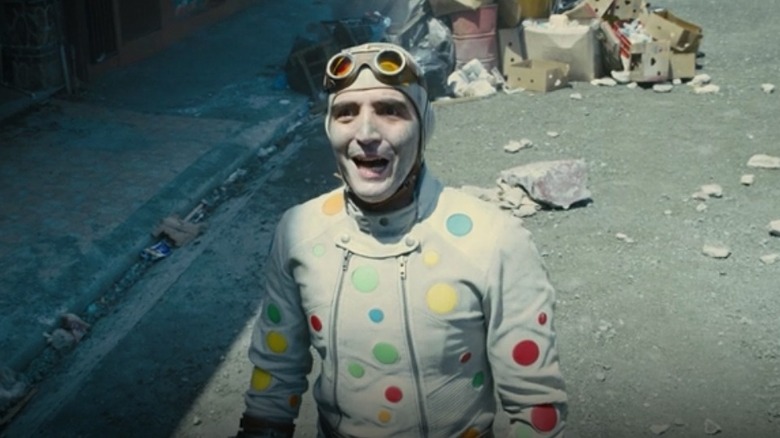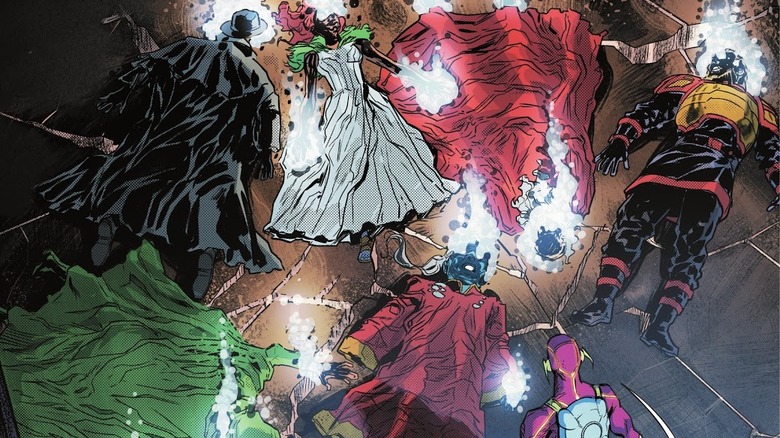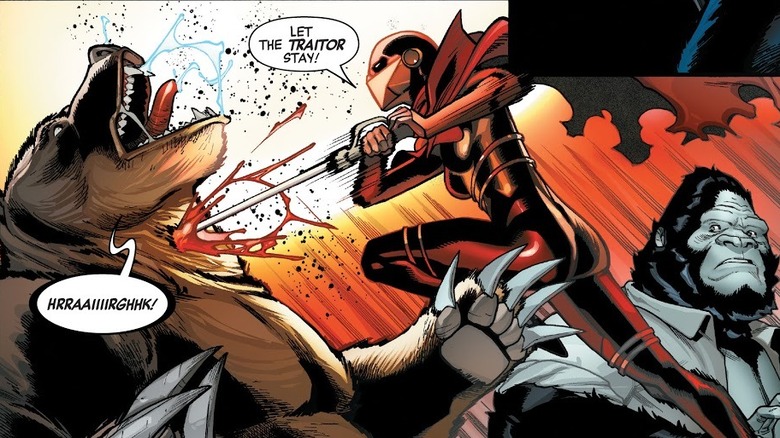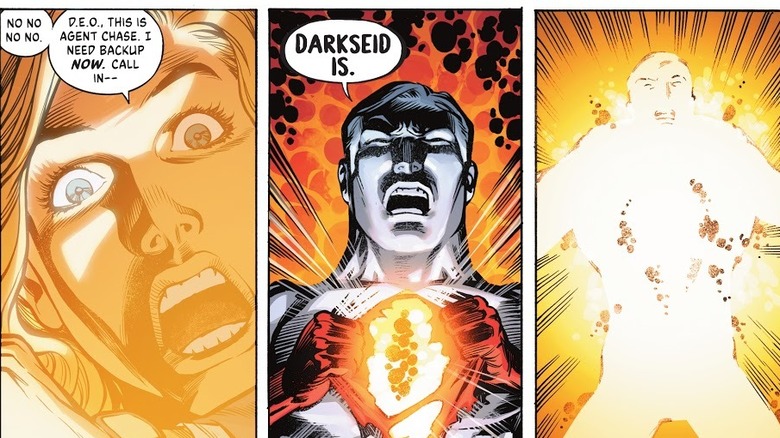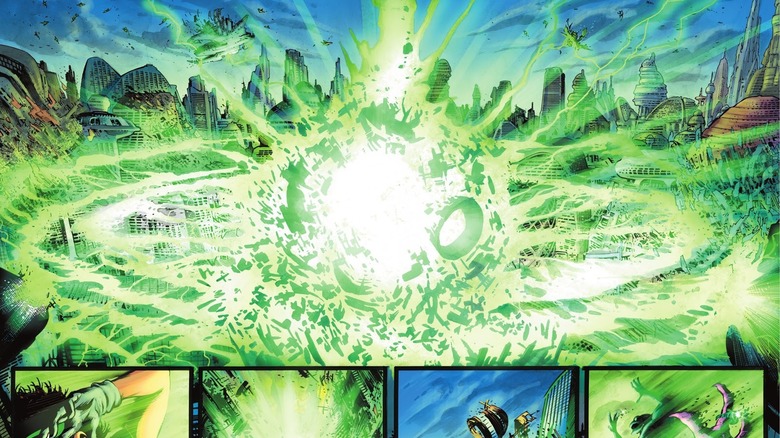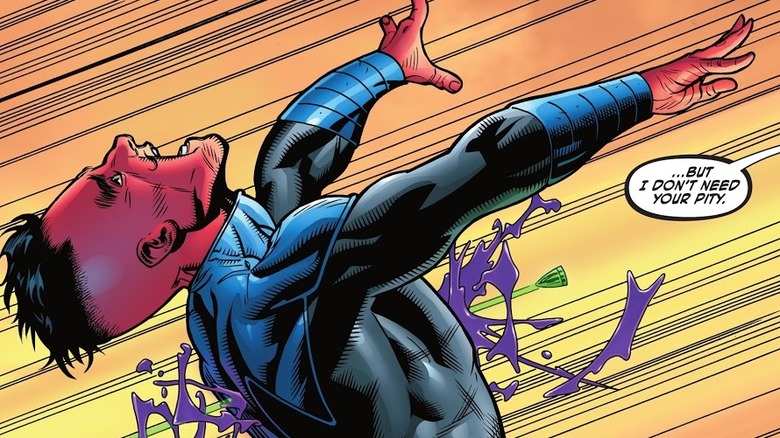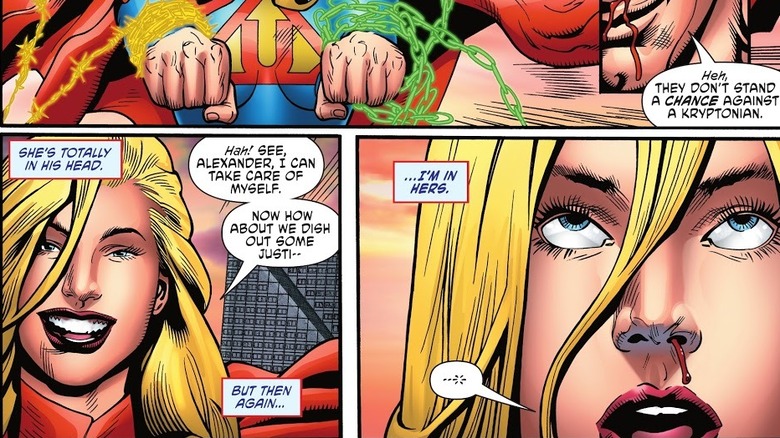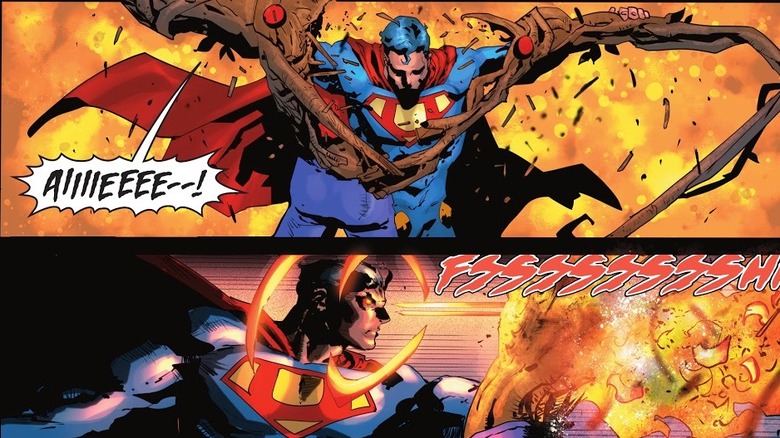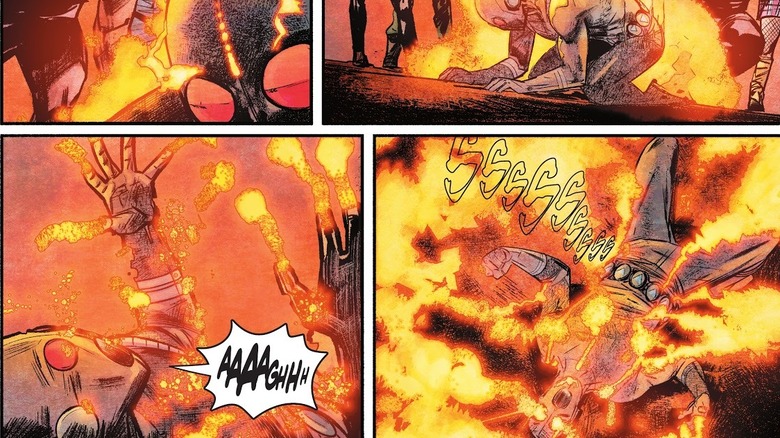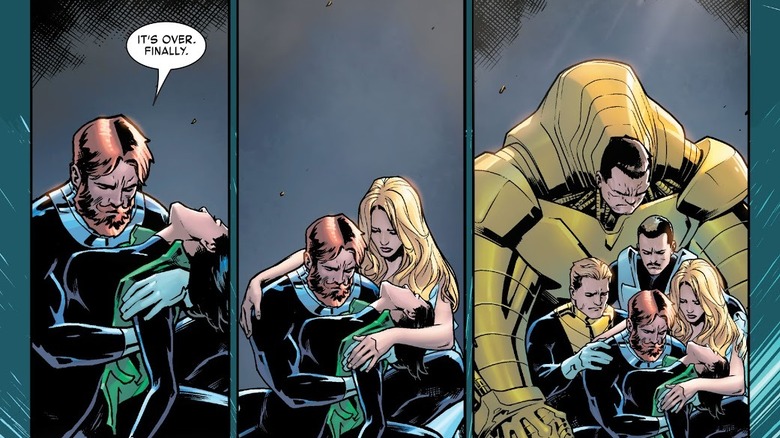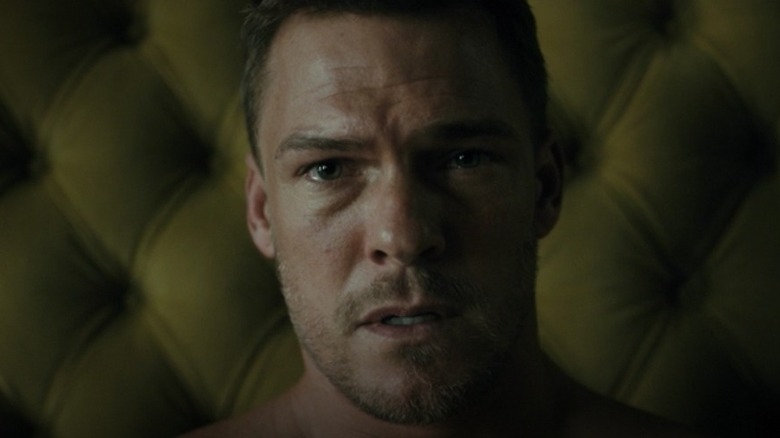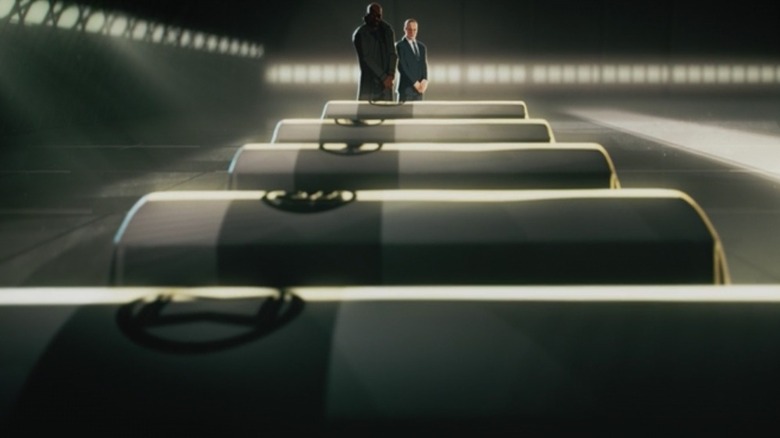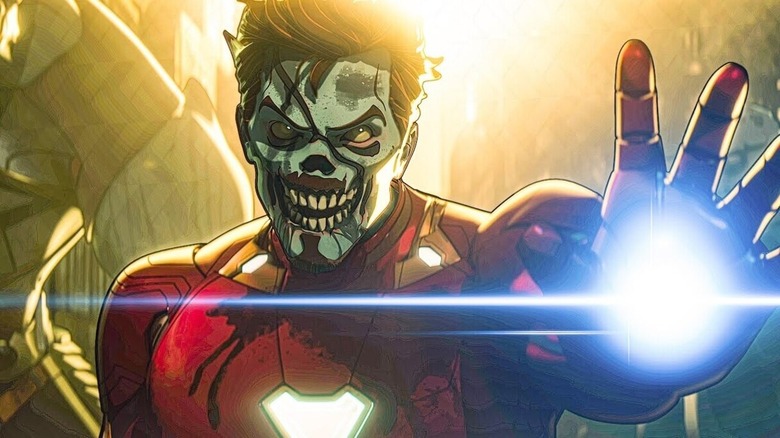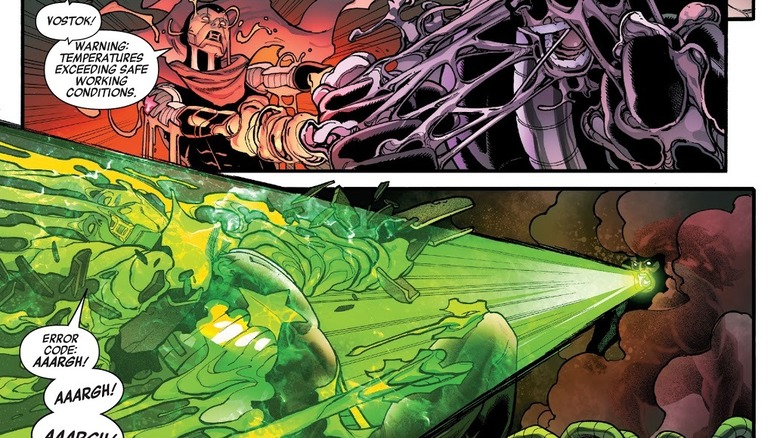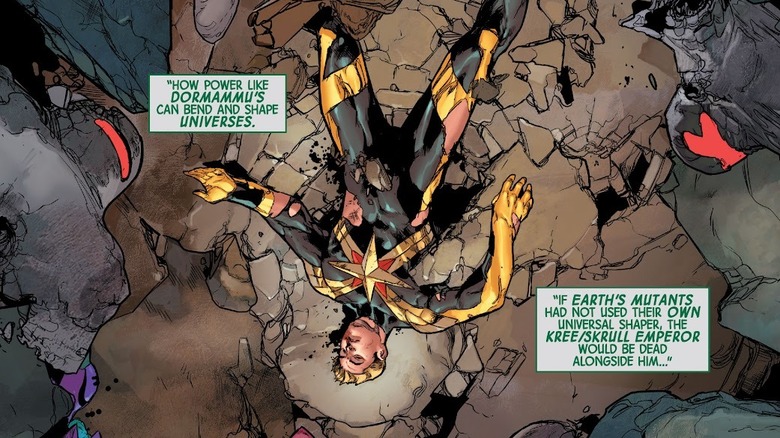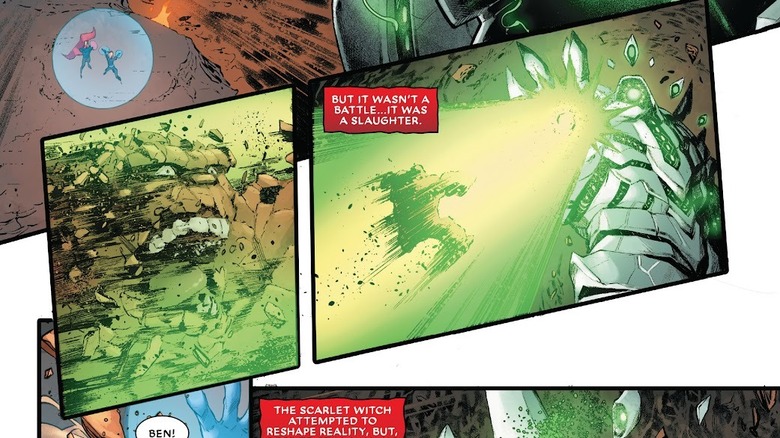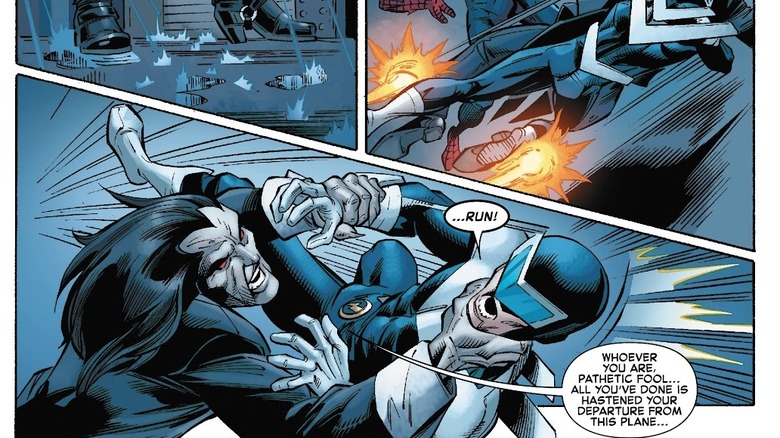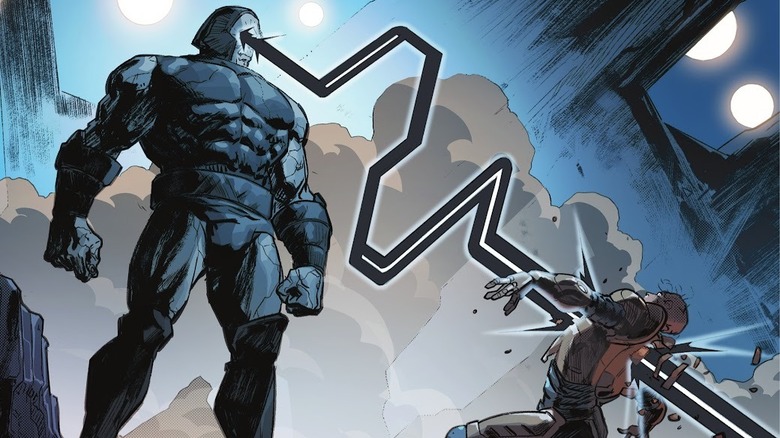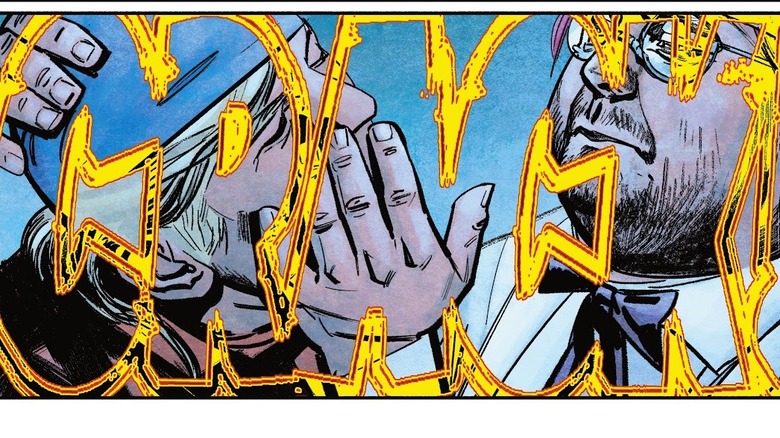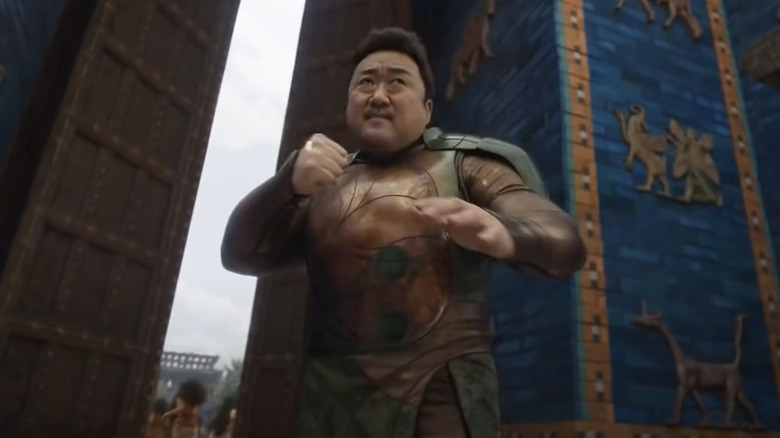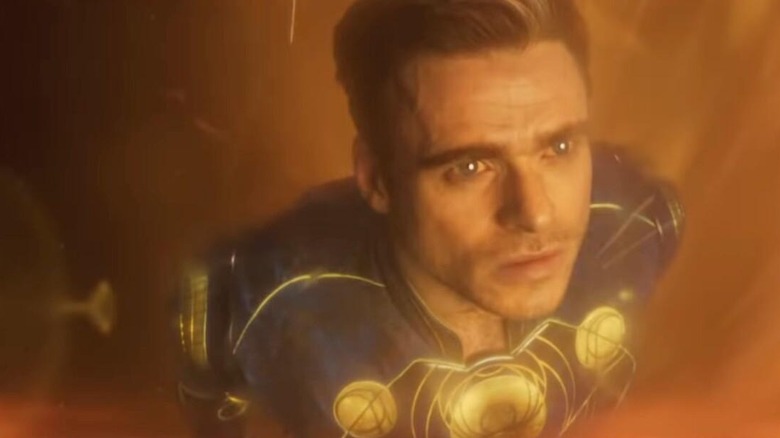Superheroes We Lost In 2021
We had a lot fewer superhero stories to enjoy in 2020. COVID-related delays in TV production, movie releases, and even comic book shipping forced superhero fans to be a lot more patient than usual. Thankfully, 2021 brought comic book champions back with a vengeance, due in large part to long-awaited original content from streaming services like Disney+ and HBO Max. With series like "WandaVision" and "Invincible," new films like "Thunder Force" and "Zack Snyder's Justice League," the resumption of CW's DC hero line-up along with the new series "Superman & Lois," and more comic books back on the stands, 2021 is shaping up to be one of the busiest years for the superhero world yet.
Sadly, more superhero stories means more costumed do-gooders meeting their ultimate fate, and 2021 has already wracked up an impressive butcher's bill of heroes. Whether they've been wiped from existence, beaten to a pulp by a treacherous ally, or forced to sacrifice themselves on the whim of cruel and ungrateful taskmasters, a good number of superheroes are sure to be dead by the end of the year.
Updated on December 14, 2021: We're making sure to keep a complete list of the super-dead so you don't have to, and as a result, we've updated this list to pay homage to our fallen fictional heroes. Whether they met their demise on a streaming site or inside the pages of a comic book, here are all the superheroes we lost in 2021. And be warned — there are major spoilers below.
The Hex Vision
Since Paul Bettany's Vision suffered a brutal death at Thanos' hands in 2018's "Avengers: Infinity War," there were — as with just about everything in "WandaVision" – plenty of theories about how Marvel's favorite synthezoid was alive in the show. In the series' penultimate episode, it's finally confirmed that, shortly after viewing her lover's disassembled body at SWORD headquarters, Wanda used abilities she didn't even know she had to create a dream Vision, along with transforming the town of Westview and its inhabitants.
The Vision of the Hex is, in Wanda's words, "the piece of the Mind Stone" living within her, a body she created, her sadness, and her hope. "But mostly," she says to Vision, "you're my love." She tells him this in the series finale, moments before she brings down her mystical Hex, along with all the illusions within it ... including Vision. Her lover seems hopeful that he will find some way to return to her before he fades into nonexistence, and who knows? SWORD's reassembled White Vision is still out there somewhere, and he could be the key to such a return.
Along with Vision, the twins Billy and Tommy also presumably fade away, but this isn't quite as certain as the dream Vision's death. In a post-credits scene, as Scarlet Witch communes with the Darkhold, we hear the boys calling out to her for help, perhaps pointing towards the twins' return in the upcoming "Doctor Strange in the Multiverse of Madness."
Yalan Gur
One of the impressive highlights of "Zack Snyder's Justice League" is the opportunity to watch an expanded and beautifully epic version of Darkseid's first effort to conquer Earth. In this flashback, we see a lot more of all the combatants, and in particular, we see a lot more of the Green Lantern who dies fighting the enemy general.
Considering who the Green Lantern is, it's fitting he should live and die in only a single flashback scene. The alien Lantern is Yalan Gur, whose counterpart in the source material is introduced in 1991's "Green Lantern" #19, likewise in a flashback that ends in his death. In the comics, Gur's story is a cautionary tale about a Lantern who's gifted with a ring with no weaknesses, and he's killed by his own overconfidence.
You could argue the movie Yalan Gur dies from the same thing since he falls going one-on-one with Darkseid, but heading straight for the big bad is kind of a Green Lantern's job. Gur is knocked out of the sky by parademons, and Darkseid takes the opportunity to dominate his foe. He chops off Gur's hand and then impales him, killing him. Gur's ring leaves his dead finger, and Darkseid reaches out to claim it, but he's interrupted by the arrows of the Greek goddess Artemis. Presumably, the ring flies away to find a new member of the Corps to succeed Gur.
Abra Kadabra
Referring to David Dastmalchian's Abra Kadabra as a superhero may seem strange. The time traveler's real name is Philippe, and he's a crook from the 64th century who uses nanotechnology that looks like magic to 21st-century eyes. He's introduced in the third season of "The Flash," stuck in the present and attempting to steal technology in order to build a time machine to get home. But he returns in Season 7's "Central City Strong," eventually proving to be a much more sympathetic character and ultimately dying to save Barry Allen.
After realizing Abra Kadabra is constructing an anti-matter bomb to destroy Central City, Flash rushes to confront him, and he learns that Phillippe is looking for payback. See, in the future, Abra Kadabra discovered the device Cisco Ramon created that could give people back their memories from before the "Crisis on Infinite Earths" crossover. Using the device on himself, Abra Kadabra learns he had a wife and son before "Crisis," but the restoration of the multiverse had taken them away from him.
Barry is able to convince the vengeful Philippe to disarm the bomb, but the danger isn't over. The monstrous Fuerza — an antagonist later revealed to be the host of the Strength Force — arrives abruptly and attacks Flash. Abra Kadabra stands up to the beast, protecting Barry, but since Philippe doesn't share Barry's enhanced healing, a single strike from the super strong Fuerza kills him instantly. In the aftermath, Team Flash agrees that Abra Kadabra died a hero.
The original Guardians of the Globe
Amazon Prime unveiled its new original animated series, "Invincible," at the end of March, and the premiere ends in a way that lets you know that while this isn't "The Boys," it also definitely isn't "Superfriends."
Early in the first episode, we meet the Guardians of the Globe — the series' version of DC's Justice League, comprised of obvious stand-ins. Instead of Aquaman, there's the fish-headed Aquarus. Instead of the Flash, there's Red Rush, and there's Darkwing instead of Batman, and so on and so on. We meet them as they're battling the formidable Mauler Twins in Washington D.C., who they defeat only with the timely arrival of Omni-Man — the show's answer to Superman and the father of the series' titular protagonist.
In spite of what at first appears to be a strong friendship between Omni-Man and the Guardians, the episode ends with Omni-Man luring the other heroes into a secret meeting and brutally murdering them all, one by one. Aquarus, Red Rush, Darkwing, the Immortal, Martian Man, Green Ghost, and War Woman are all dead before the scene ends, with Omni-Man not bothering to give his victims any explanation. But in the Season 1 finale, Omni-Man admits to his son, Invincible, that he murdered the Guardians because, as it turns out, he's not on Earth to protect it. Instead, he's here to prepare the planet to be conquered by the interstellar Viltrumite Empire.
We also learn that at least one of the original Guardians might actually return. In Season 1's penultimate episode, the Mauler Twins resurrect the Immortal with the intention of using him for their own plans. Instead, the Immortal finds and attacks Omni-Man, who kills the Immortal once more. However, in the Season 1 finale, we get a brief shot of the Global Defense Agency working on the Immortal's corpse, suggesting at some point in the near future, the dead hero may get another shot at his killer.
Battlestar
"The Falcon and the Winter Soldier" has been decidedly ambiguous regarding the fate of Steve Rogers. We still don't know if he's dead, retired in secret, or on the moon like Joaquin Torres and his buddies seem to think. But we know of at least one hero who doesn't survive the series. In Episode 4, Lemar Hoskins, aka Battlestar, sacrifices himself to save John Walker from the Flag-Smashers.
The head of the Flag-Smashers, Karli Morgenthau, decides the new Captain America needs to die in order to send the world a message. She sets up a meeting with Sam, knowing that John Walker will follow whether he's invited or not. Walker does what's expected of him, and in the ensuing melee, one of Karli's men gets ahold of him while Karli charges him with a knife drawn. Lemar intercepts Karli, tackling her to the floor. Enraged, the Flag-Smasher hits Lemar with all of her enhanced strength, sending him flying backward into a pillar and killing him instantly.
Battlestar was John Walker's best friend and his biggest cheerleader. His death pushes the already unstable Walker over the edge, and at the end of the episode, he murders one of the Flag-Smashers in a very public and brutal fashion. Episode 5 opens with Sam and Bucky clashing with Walker to take back his bloody shield, and before long, Walker has returned to the States, where the title of Captain America is stripped from him.
Bolt
In spite of "Suicide Squad's" premise being that no one is safe, certain eras have filled the line-up with far too many too-big-to-die characters. For example, the volume of "Suicide Squad" that premiered in 2011 as part of DC's New 52 reboot regularly included characters like Harley Quinn and Deadshot, each of whom you could safely predict would survive to the next issue. But if you like your "Suicide Squad" body count to be a bit higher, the volume that premiered this year is for you. Four members of Task Force X break into Arkham Asylum in 2021's "Suicide Squad" #1, and all but one of them are dead by the issue's end.
The first to fall is Bolt, and ironically, he's killed by the guy he's there to free. The Suicide Squad's mission is to rescue William Cobb — the Court of Owls' most infamous Talon — but when the Squad gets into his cell, it's clear the guy is in a psychiatric facility for good reasons. Cobb is huddled in a corner, seemingly unaware of them, and the word "who" is carved into just about every inch of his cell's walls. When Bolt puts his hand on Cobb's shoulder, the latter strikes, ripping Bolt's throat open with one of his homemade shivs.
The Bolt who dies in "Suicide Squad" #1 is actually the son of the original DC villain who bore the name. The younger Bolt killed his own father at the orders of the Clock King in 2009's "Terror Titans" #3.
Film Freak
Earlier in March, DC released "Infinite Frontier" #0, which included — among other things — an attack on Arkham Asylum with Joker's deadly gas. Those events spill into "Suicide Squad" #1, shrinking Task Force X considerably.
After killing Bolt, William Cobb doesn't prove any more cooperative with the team sent to free him, taking on the survivors Shrike, Film Freak, and Peacemaker all on his own. As the deadly Joker gas creeps towards the group, Cobb punches Film Freak, knocking him closer to the oncoming cloud. As the gas overtakes him, Film Freak quotes the famous Porky Pig line, "That's all folks," before taking on the rictus grin that all of Joker's gas victims display.
First appearing in 2006's "Catwoman" #54, the pale-skinned Film Freak is a psychopath obsessed both with movies and with Catwoman. Before his death, his mind possessed no true memories but only clips from countless films. In his final appearance in "Suicide Squad" #1, he speaks exclusively in quotes from movies, TV shows, and song lyrics.
Shrike
The last Squad member to fall in "Suicide Squad" #1 — but not the last Squad member to fall in this story — is Shrike. A student of the notorious League of Assassins, Shrike existed primarily as an antagonist for Batman's first partner — Dick Grayson, better known as Nightwing and also as the first Robin of Gotham City. And as for his ultimate fate, depending on how you look at it, Shrike dies either because of his only surviving teammate's betrayal or because he's simply a low priority.
After Film Freak dies, Peacemaker and Shrike continue to try to subdue William Cobb, forcing him toward a nearby exit in the hopes of escaping the Joker gas. As they reach the exit, they find two guards blocking their escape, and Peacemaker tells Shrike to take care of the guards while he grabs Cobb and charges with him through the exit. In spite of Shrike calling for him to wait, Peacemaker keeps going, allowing the exit door to close behind him and leaving Shrike to die in the encroaching gas.
Mindwarp
Before the end of "Suicide Squad" #1, we learn that Amanda Waller has Superboy as her prisoner. In the following issue, she sends a second squad led by Superboy — equipped with gas masks — to Arkham Asylum to rescue Cobb and Peacemaker and to leave a corpse in Cobb's cell in the hopes he'll be presumed dead. Superboy's squad includes the vampiric Batman villain Nocturna and three characters making their first appearance in "Suicide Squad" #2 — Culebra, Exit, and Mindwarp.
With the ability to psychically manipulate others, Mindwarp uses his powers to force any surviving Arkham guards to forget about the squad. But just as the team is about to leave, Mindwarp's mask cracks, exposing him to the Joker gas. He quickly collapses, succumbing to the fumes and dying.
While it's only speculation, the timing of Mindwarp's death is suspicious. Waller calls him over the comms and has him confirm that his powers worked on the guards. As soon as he confirms, his mask cracks without any visible outside influence causing the damage. Earlier, Peacemaker's narration refers to Mindwarp as a "true psychopath," and he calls him "untrustworthy." Perhaps — uncomfortable with the supposed "psychopath" on her squad — Waller causes Mindwarp's mask to crack remotely once she has what she needs from him.
As for his backstory, while there is a Mindwarp named Jay Young who was introduced in 2012's "Justice League Dark" #3, Peacemaker's narration notes this Mindwarp's real name is Peter Howard, making him a completely different and new character.
Exit
Though he hasn't been seen before in DC Comics and presumably won't be seen again (at least not for a while), the most sympathetic of Task Force X's members to fall in the first two issues of "Suicide Squad" is Jason Phillips, aka Exit. Peacemaker's narration calls him a thief with "delusions of redemption." If Peacemaker is right and Exit's hope for redemption is a delusion, then it's a delusion he dies feeding.
Shortly before the squad leaves Arkham, Superboy argues with Amanda Waller when she orders him to leave without helping any of the facility's survivors. He argues they "just need time," and likewise, Exit tries to save one of the Arkham guards by letting him use his own gas mask. Sadly, that act of kindness seals Exit's fate. On the following page, the gas overtakes Exit. Before dying, he opens a portal so the rest of the squad can escape.
Keymaster
In the new volume of "Suicide Squad," the first two issues both see a team member with teleporting powers kick the bucket. "Suicide Squad" #3 continues the streak with its new member, Keymaster.
In "Suicide Squad" #3, Amanda Waller sends the team to forcibly "recruit" Bolt of Teen Titans fame into the squad. To help capture the speedster, Waller introduces two new team members (and likewise, both make their first DC Comics appearance in this issue). Branch is a chronically nervous and cowardly science experiment with a body that has vegetative properties, while the arrogant, smart-mouthed Keymaster creates portals that allow him to teleport himself and others across great distances.
Unfortunately, Keymaster doesn't know one of the most important rules of Task Force X. Of the fastest ways there are to die in the Suicide Squad, trying to escape is near the top of the list. While the team waits to ambush Bolt, Branch suggests Keymaster might be able to create a portal that would teleport them far enough away to escape the range of the explosives implanted in their bodies. Keymaster agrees, quipping, "Good idea, Treebeard. Too bad there's only room for one." Predictably, Waller detonates the explosives within Keymaster, killing the Squad member and warning Bolt of the ambush. And as is usually the case for the Suicide Squad, everything goes sideways after that.
Mary Brighton
On the series premiere of the HBO original "The Nevers" — set in London at the end of the 19th century — we learn a mysterious object flew over the city four years before the events of the show, scattering a glowing substance over the populace, granting some of them superhuman abilities. Those with abilities soon become known as the Touched. Feared by other Londoners, some of the Touched take shelter in St. Romaulda's Orphanage run by Amalia True.
One of the Touched is Mary Brighton, whose ability is unique. Brighton's singing can only be heard by other Touched, and upon hearing it, they're soothed. In an effort to bring hope and union to the Touched, inventor Penance Adair creates an amplifier she hopes will allow Brighton's song to reach every Touched in London. Hesitant at first, Brighton eventually agrees to Penance's plan, but mid-song, she's abruptly riddled with bullets by Winemar Kroos — a criminal Touched with a Gatling gun-like prosthetic arm and the ability to fire bullets from his body. Brighton dies almost instantly.
Kroos is killed by Inspector Frank Mundi moments later, but later in the series, we learn it's the powerful Lord Gilbert Massen who arranged for Brighton's murder.
Flaming Fist
Netflix's "Jupiter's Legacy" is based on the comics of the same name, written by Mark Millar. As co-creator of the "Kick-Ass" comics, Millar is known for plenty of bloodletting in his superhero stories, and the premiere episode of "Jupiter's Legacy" serves as a prime example. Not only does "By Dawn's Early Light" kill off three superheroes, but the first one is snuffed out before even getting to throw a punch (though considering everything, that last part is pretty much his own fault).
Toward the end of the episode, the superhero team known as the Union gathers to battle what we later learn is a clone of the supervillain Blackstar. Ruby Red descends from the sky to find Flaming Fist watching the battle from — what he believes to be — a safe distance. He tells Ruby Red his plan is to wait until the more powerful heroes to do most of the damage against Blackstar and then show up "at the end for the photo op."
Unfortunately, the battle winds up coming to him. While Flaming Fist and Ruby Red chat, the battling forms of Blackstar, the Utopian, and Lady Liberty fly straight at the pair. Ruby Red tries to warn Flaming Fist, but it's too late. The fiery hero is struck and killed by the warring trio.
Phaseout and Tectonic
Flaming Fist isn't the only victim of Blackstar's clone in the premiere episode of "Jupiter's Legacy." Two more heroes fall victim to the supervillain — Phaseout and Tectonic.
Not long after Flaming Fist's death, Brainwave's psychic assault briefly gives the Union the upper the upper hand against the Blackstar clone. Urged on by the Utopian's son, Paragon, Tectonic uses his earth-controlling powers to stun the bad guy, and Phaseout moves in to finish him off. Unfortunately, her choice has tragic consequences, as the Blackstar clone quickly overpowers Phaseout and decapitates her with a single blast from his anti-matter heart. And that same anti-matter beam instantly kills Tectonic.
Of the two heroes, we only get a chance to know Tectonic before his death, and we don't get to know him very well. He appears earlier in a nightclub, where it's clear he's Paragon's close friend and confidant. His death helps push Paragon over the edge, convincing him to end the Blackstar clone's rampage by killing him — thereby breaking his father's code of superhero conduct and setting up one of the series' major thematic conflicts.
Ghost Beam
The "Jupiter's Legacy" body count doesn't end with the death of Blackstar's clone. Considering the growing sense within the Union that the Utopian's non-lethal code has outlived its usefulness, the final superhero death in Season 1 is something of a cruel irony. In "Cover Her Face," one of the only heroes on the show to unambiguously support the Utopian's code dies fighting evil.
We don't see the fight that kills Ghost Beam, but we see the result. Lady Liberty responds to an emergency call, and when she arrives, the police tell her a villain was "tearing up half the block" and that Ghost Beam chased him inside an abandoned building. Lady Liberty follows, and after hearing distant sounds of battle, Ghost Beam appears. She's mortally wounded, bleeding from her head and abdomen. She dies in Lady Liberty's arms, gasping that her killer was the supervillain Baryon and that she "didn't break the code."
Just as Tectonic's death helps convince Paragon to kill the Blackstar clone, Ghost Beam's sacrifice serves to make Lady Liberty question her husband's code. She faces off with Baryon — a villain who wields powerful energy blasts — and is clearly tempted to kill him. While she beats him into submission, however, she ultimately spares his life.
An unidentified Avenger
"If Bureaucracy Be... Thy Death!" — Episode 5 of the Hulu series "Marvel's MODOK" — has a lot of fun messing with the audience. In a flashback, we learn Monica Rappaccini murdered an Avenger right after she was recruited into AIM, and in the aftermath, MODOK took credit for the kill. It's one of the main reasons present-day Monica despises the big-headed supervillain she once idolized.
But we never find out exactly who Monica kills. Arriving at the scene, MODOK tells Monica, "I wanted to kill an Avenger, but you took down one of the main ones!" He goes on to call the hero a "huge character" and an "incredibly essential Avenger." The only real hint is the shot of their smoking skull, which shows that — whoever they were — they wore a red mask.
Proving once again that speculation is at least half the fun of any Marvel TV series, fans quickly started guessing the ID of the snuffed hero. Some put in a bid for Daredevil, while others went with Giant Man. Giant Man fits more with the description of "one of the main ones." Daredevil's comic book stints as an Avenger have been brief. Meanwhile, the Hank Pym version of Giant Man is one of the team's founders in the comics, and Scott Lang is one of the most popular heroes in the movies. Then again, MODOK is prone to exaggerate his accomplishments — or, in this case, the accomplishments he's poaching — so who knows?
Balder the Brave
Whichever Avenger dies in Episode 5 of "Marvel's MODOK," the series' superhero kill count isn't quite finished. The following episode — "Tales from the Great Bar Mitzvah War!" — opens in Asgard, with Thor's half-brother Balder the Brave rallying troops in the hopes of finding the "evil sorcerer" who created a portal above the golden city and is dropping garbage and various office supplies through the gateway. Balder is mid-sentence when a large office shredder buries itself in his skull, killing him instantly and spraying all the nearby troops with his blood. We soon learn, unsurprisingly, the "trash portal" is MODOK's creation, which he made for the sole purpose of messing with Thor.
While Balder has yet to appear in the MCU, he's been part of Marvel's comics for decades. He's introduced in 1962's "Journey Into Mystery" #85, only two issues after Thor's first appearance. He's a regular ally of Thor and other Asgardian heroes, and for a time, he even rules Asgard in Odin's place.
In Norse mythology — and, for a while, in the comics — Balder is vulnerable only to mistletoe, and his death is meant to be the first sign that Ragnarok is approaching. But unless MODOK stuffed the shredder with mistletoe beforehand, and since "Marvel's MODOK" Season 1 ends without Ragnarok destroying everything, we're guessing this should be filed under "it's just stop-motion animation, stop being so pedantic."
Classic Loki
In a post-credits scene for "The Nexus Event" — Episode 4 of "Loki" — we meet a quartet of Loki variants, including Classic Loki. Played by Richard E. Grant, this Loki's outfit is the most comic book accurate we've seen so far in terms of the god's old-school look. Sadly, the older Loki doesn't survive to see the credits of the following episode.
When Sylvie devises a plan to enchant the cloud beast Alioth in order to reach the mystery villain behind the Time Variance Authority, Classic Loki initially seems to want no part of it. But once the plan is hatched and seems to be falling apart, Classic Loki appears. Having used his years perfecting his magic — as opposed to splitting his time with martial combat like the younger Lokis — Classic Loki is able to create the massive illusion of a fully formed Asgard.
Classic Loki's illusion does its job and distracts Alioth long enough for Sylvie and the younger Loki to regroup and eventually enchant Alioth. But before that happens, Classic Loki falls. Alioth figures out the deception and turns on the creator of the false Asgard. Classic Loki screams "glorious purpose!" defiantly at the beast, cackles madly, and is devoured. His horned helmet crashes to the ground where he stood only moments before.
Blackguard
"The Suicide Squad" finally arrived in August 2021, and whether or not you're a fan of its predecessor, one thing you have to admit is that its body count helps the film live up to its title much better than 2016's "Suicide Squad." Over half of Amanda Waller's leashed supervillains are dead within the first 15 minutes of the film, and while we're fooled into thinking the first to fall is Weasel — who somehow revives right before the credits roll — the first Task Force X member to die and stay dead is Blackguard, and he really has no one to blame but himself.
As Rick Flag's team approaches the Corto Maltese beach, Blackguard leaves the safety of cover and steps out into the open. We soon learn that Blackguard has turned on his teammates, though how he does so remains one of the film's unanswered questions. Blackguard begins yelling things out into the nearby jungle like, "Look, look I brought everybody!" And as the Corto Maltesean soldiers turn their lights on, Blackguard yells, "We got a deal right? I'm the one who called you!" A shot rings out, and suddenly, Blackguard no longer has a face. He drops to the ground dead.
Fans of the comics were no doubt unsurprised with Blackguard's fate. In the source material, Blackguard is abruptly murdered by his turncoat teammate General Wade Eiling in 2008's "Suicide Squad" #7.
Captain Boomerang
The second Squad member to fall in "The Suicide Squad" — and the first who also appears in the 2016 predecessor — is Jai Courtney's Captain Boomerang. Along with Harley Quinn, Boomer is one of the first to fight back against the Corto Maltesean soldiers after they open fire. We see one of his glowing boomerangs kill a number of the troops, but unfortunately, it's another squad member's bungle that means the end for the projectile-slinging Aussie.
When Mongal tries to take down the enemy helicopter on her own, it ultimately works, but it does more harm to Task Force X than good. As the chopper struggles to right itself, the blades rip through the nearby jungle. Captain Boomerang is impaled by multiple large splinters from the devastated trees and falls to his knees. Seeing he's in trouble, Harley calls out to her comrade from cover. In his final moments, Captain Boomerang smiles at Harley ... until the fiery helicopter races toward him and rips him to pieces. Later, we see his severed arm sticking up out of the ground, still gripping one of his glowing boomerangs.
Mongal
Of all the DC Comics characters appearing in "The Suicide Squad," Mongal is arguably the most thoroughly power-nerfed in comparison to the source material. In the comics, Mongal is a heavy-hitter who would not only easily survive taking out a helicopter but could hold her own against some of DC's strongest heroes and villains.
Unfortunately, Mongal's physically weakened adaptation does not survive the Corto Maltesean beachhead. She succeeds in taking out a helicopter, but it probably would've been better if she hadn't. Not only does the helicopter's crazy trajectory and subsequent crash lead to the death of Captain Boomerang, but it ultimately kills Mongal as well. In the wake of the chopper's crash, the alien warrior is pinned beneath part of the vehicle and engulfed in flames. She thrashes helplessly underneath the thing, screaming all the while. Her death is confirmed shortly afterward when we see her still, smoking corpse.
Savant
Savant is the first Squad member we meet in "The Suicide Squad," and initially, the direction leads us to believe he may very well be the most hardcore, formidable warrior of the bunch. In the beginning of the film, he's enjoying what's apparently a regular past-time for the criminal — bouncing a rubber ball off walls and predicting exactly where it'll strike. Cruelly, he uses this ability to kill a small bird just before Waller arrives to collect him. When he's introduced to the rest of his team, he acts thoroughly unimpressed, coming off like Batman if he was forced to work with the Muppets.
But when push comes to shove, Savant makes the same mistake Slipknot did in 2016's "Suicide Squad" — he runs. During the beachhead battle, Savant only leaves the cover of the beach wall to see how the rest of the team is getting cut to pieces. Screaming in fear, he then turns tail and runs back into the ocean. In spite of multiple warnings from Waller over the comms, Savant's fear pushes him farther away from the island. Waller detonates the bomb in the back of his neck, killing him. Later, James Gunn treats us to a bit of poetic justice, as we see the same kind of bird Savant killed earlier snacking on his floating remains.
Javelin
While Javelin is riddled with bullets shortly before Savant makes his ill-advised retreat, he survives a bit longer than his teammates. Dying in the sand, Javelin tells Harley she's the only one fit to carry his Javelin. His final words are, "Carry it for..." but he dies before he can say for what. Characteristically, Harley complains both to Javelin's corpse and to the soldiers who capture her about his failure to finish his sentence.
It's at this point we feel we should address the elephant in the room. You may notice that we haven't included Nathan Fillion's T.D.K. on this list. That's because, in spite of numerous reports to the contrary, we never see T.D.K.'s death in the film. The last we see of him, things certainly don't look good for him. He's armless, and he's coughing up blood. But in spite of the folks back at Task Force X headquarters marking the profile photos of the majority of the team with "DECEASED" and filling the pictures in with the color red, T.D.K.'s profile photo never gets the red coloring and only ever says "CRITICAL CONDITION."
Now, you may understandably ask how T.D.K. could possibly survive his predicament. We can only point out that you'd be just as right to ask the same thing about Weasel and Peacemaker, and yet somehow both survive even though — unlike T.D.K. — we see both of them "die."
Rick Flag
Whether it's intentional or not, it seems like when it comes to veterans of 2016's "Suicide Squad," their violent ends tend to come — directly or otherwise — at the hands of their teammates. While Mongal's actions unintentionally lead to the death of Captain Boomerang, it is very much Peacemaker's intent to kill Rick Flag toward the end of "The Suicide Squad," though he clearly doesn't enjoy doing it.
When the Thinker proves to Rick Flag that the United States government not only already knew about Starro but is actually responsible for bringing the creature to Earth and funding experiments on the creature, Flag vows to expose the conspiracy via a computer drive with all the relevant data. But after retrieving the drive, Flag finds himself threatened by Peacemaker, who we learn was secretly tasked by Amanda Waller to make sure the records don't leave Jotunheim.
A brutal fight ensues between Flag and Peacemaker, and Flag doesn't survive. Throughout the battle, while Peacemaker refuses to relent, it's clear he's conflicted about what he's doing. Flag temporarily gains the upper hand, pinning Peacemaker to the ground and choking him, but Peacemaker grabs a nearby broken shard of porcelain and drives it through Flag's chest and into his heart. The colonel's last words are, "Peacemaker. What a joke."
Polka-Dot Man
If Mongal is the most nerfed DC Comics character in "The Suicide Squad," David Dastmalchian's Polka-Dot Man — superpower-wise at least, if not in terms of mental stability — gets perhaps one of the biggest boosts. Unlike his comic book counterpart, whose dot projectiles spring from a high-tech suit, this version of Abner Krill suffers an interdimensional virus that will eat him alive if he doesn't release the deadly polka dots from his body at least a few times per day. And while, yes, he looks like a walking Twister mat, his dots are quite deadly, and he manages to cripple the massive Starro all on his own in the final climactic battle.
Sadly, Polka-Dot Man doesn't hurt the alien beast quite enough to survive. Bloodsport lures Polka-Dot Man out of hiding by telling him Starro is his mother. Looking, Abner sees — as he usually does — his mother in place of the giant alien. He lets loose his polka dots, damaging one of Starro's limbs enough that all of the alien's thralls scream out in unison. But right after Polka-Dot Man triumphantly yells out that he's a superhero, his celebration is cut short as one of Starro's limbs crushes him.
The Quintessence
As a part of DC Comics' 2021 "Infinite Frontier" relaunch comes the mini-series of the same name, and it starts off with the grisly deaths of some of the most powerful characters to ever appear in the mythos.
Throughout 2021's "Infinite Frontier" #0, interspersed with moments from across the DC Universe, we get scenes of the Quintessence speaking with Wonder Woman and attempting to recruit her to their ranks. The Quintessence is a reality-manipulating council of what can only be described as gods. There's Highfather of the New Gods, Ganthet of Oa's Guardians of the Universe, the Phantom Stranger, the Spectre, the goddess Hera, and the wizard Shazam. Thankfully, Wonder Woman ultimately turns down their offer of membership because, otherwise, she'd probably be dead right now.
Toward the end of the issue — ironically right after the wizard says, "There is nothing we cannot control or defeat" — Darkseid emerges. Reconstituted from other versions of himself from across the multiverse, Darkseid is more powerful than ever, and he easily murders all six members of the Quintessence, impaling them with dark energy and stomping on their corpses.
Ursa Major
In "Avengers" #46, the Russian super team the Winter Guard — with the help of the traitorous Gorilla-Man — invades Avengers Mountain and kidnaps She-Hulk. Their justification for the assault is the battle She-Hulk wages with Namor in Moscow in "Avengers" #43-44 and the resulting damage it causes. In truth, they want to bring Jennifer Walters back to Russia in order to brainwash and transform her into their puppet. Ursa Major — a mutant with the ability to transform himself into the form of a super strong bear — doesn't survive the incursion, though it isn't an Avenger who kills him.
Having made a deal with Dracula and the Winter Guard, Gorilla-Man sabotages the defenses of Avengers Mountain and makes it easier for the Russian team to isolate She-Hulk and fight her on their own. While She-Hulk almost manages to escape them, the synthezoid Vostok ultimately subdues her. As the team is on their way out of the mountain, Ursa Major whispers to Gorilla-Man, indicating the mutant apparently turned on his team and tried to help the Avengers in secret. When Vostok yells to Ursa Major that the team is leaving, Red Widow responds, "No, that is all right. Let the traitor stay!" and stabs Ursa Major through the neck, killing him.
While Ursa Major wasn't technically a founding member of the Winter Guard, he was a founding member of their pre-glasnost predecessors, the Soviet Super Soldiers, who first appeared as a group in 1981's "Incredible Hulk" #258.
The Captain Atom of an unknown Earth
Captain Atom — famous for, among other things, being the inspiration for Doctor Manhattan of "Watchmen" — died during last year's line-wide DC Comics event "Dark Nights: Death Metal." The hero — or, at least, a version of him — returns in "Infinite Frontier" #2, but he isn't alive for long.
The issue opens with DEO Agent Cameron Chase at the Hall of Justice to talk to Superman and Batman about the reborn multiverse that's now common knowledge on the prime DC Earth, Earth-0. However, the Justice League members are called off on an emergency, and Director Bones sends Chase to Metropolis Air Force Base to recruit Captain Atom to their cause.
When Chase arrives, Captain Atom seems uninterested and says he's retiring. Sensing something is off, Chase mentions a mission in Markovia that never actually happened. When Captain Atom takes the bait, Chase pulls out her gun and reveals her deception, believing this Captain Atom to be from another Earth. He tells Chase he doesn't know where his Earth-0 counterpart is, and when Chase asks him which world he's from, he answers, "Does it matter?" He tells her he knows too much and cannot allow himself to be taken in. He then rips open his containment suit as he says the dreaded words spoken by the servants of Darkseid, "Darkseid is." Opening the suit causes a nuclear explosion, killing himself and almost everyone on the base, but Chase is teleported away at the last moment.
Most of the Green Lantern Corps
At the end of "Green Lantern" #2, the central power battery on Oa explodes. Along with all people killed in the explosion, the destruction of the battery leaves most of the Green Lantern Corps defenseless. Almost every single Green Lantern ring loses its power after the death of the battery, leaving many Lanterns missing, others caught in the void of space without their ring to protect them, and still more as prey for enemies of Oa who've long been waiting for such an opportunity.
In "Green Lantern" #4, we begin to get a more complete list of living Lanterns, dead ones, and the missing. While a few names of the dead are of Corps members never before seen in the comics, more than you might expect are classic, beloved characters. In particular, on Oa, Sojourner Mullein receives word that Arisia Rrab and Isamot Kol — who we saw floating in space in the previous issue — are confirmed dead. Meanwhile, John Stewart is trapped on Sergilon. After fighting a group of slavers, he learns they've killed and collected bounties on 300 members of the Corps. He has the slavers' computers read the names of dead Lanterns, and there are at least five who've appeared in previous comics: the stony-skinned Ash-Pak-Glif, Morro, Palaqua, Vath Sarn of Rann, and the aquatic Naut Ke Loi, whose origins go all the way back to 1961's "Green Lantern" #9.
Thaal Sinestro of Earth-3
On Earth-3, what you know about the prime DC Comics continuity is in many ways turned on its head. Heroes are villains, and villains are heroes. Instead of the Justice League, for example, the premiere super team on Earth-3 is the Crime Syndicate, with the brutal Ultraman replacing Superman, the nihilistic Owlman replacing Batman, the ring-enslaved Emerald Knight replacing Green Lantern, and so on. In the miniseries "Crime Syndicate," the only heroes with any hope of defeating the Syndicate are a part of the Legion of Justice. With the help of Thaal Sinestro, at the end of "Crime Syndicate" #4 , they recruit John Stewart (the Emerald Knight) to their cause.
In "Crime Syndicate" #6, Thaal fights to keep Emerald Knight on his side while Superwoman – Earth-3's dark answer to Wonder Woman — hopes to bring him into the Syndicate. After John goes wild, slaughtering many of the warriors of Demon's Island, Superwoman uses her lasso to rip Stewart's ring finger off. Thaal uses his own ring to restrain her while he tries to talk Stewart down, telling him he's a victim of his superpowered jewelry and that Thaal plans to help him recover. Responding that he doesn't need Thaal's pity, Stewart summons his ring, making sure it rips through Thaal's chest on its way back to him. Thaal falls to his knees, gasps that he and John were supposed to change the world, and dies.
Ultragirl
At the end of "Crime Syndicate" #5, Alexander Luthor — leader of the Legion of Justice — pulls out the proverbial ace in the hole. Unbeknownst to anyone, Ultraman's cousin, Kara (aka Ultragirl), is working with Luthor. It turns out that Ultragirl is one of the few Earth-3 characters who's a hero on her world and, as Supergirl, a hero on Earth-0. Arriving on Earth after her cousin had already become a villain, Ultragirl is ashamed of Ultraman and agrees to help Luthor defeat him.
Shocked that he isn't alone on Earth after all, Ultraman uncharacteristically tries to convince Ultragirl that they don't need to fight in "Crime Syndicate" #6, even as she vows to kill him. He even shows pride at his cousin's might as she shakes off the restraints of both Superwoman and Emerald Knight. But unseen in the melee is Atomica — Earth-3's version of the Atom — who shrinks, sneaks her way into Ultragirl's head, and kills the hero by crippling her brain.
We should also mention there's a really good chance Alexander Luthor is dead, but it isn't a certainty. Moments after Ultragirl's death, the grieving Ultraman grabs Luthor and flies away, but while we don't see Luthor's fate, Ultraman later refers to him in the past tense. While on one hand, it's difficult to imagine Ultraman wouldn't kill him, it's conceivable Ultraman imprisons Luthor for the chance to inflict some form of creative torture.
Branch
Usually, when a new member of Task Force X is recruited and has never appeared in DC Comics before, you can pretty much bet they won't live to see another issue. So the vegetative recruit Branch — introduced in "Suicide Squad" #3 — should actually feel proud he lives three issues and change before meeting his end.
In "Suicide Squad" #5, Bloodsport is sent to Earth-3 to recruit Black Siren, that world's version of Black Canary. And in "Suicide Squad" #6, Amanda Waller sends a squad led by Superboy to Earth-3 to retrieve both Bloodsport and Black Siren. Shortly after they materialize on a Metropolis rooftop in Earth-3, Ultraman attacks and knocks Nocturna off the roof. Branch rushes to the edge of the rooftop and extends his arms as branches to grab Nocturna and save her. As he lowers her to the ground, he yells, "I've got you!" Standing behind Branch, Ultraman says, "And I've got you."
Before anyone can respond, Ultraman rips Branch's body in half and burns his remains with his heat vision, leaving nothing but smoke and ash.
Firefly
In the DC Black Label comic "Suicide Squad: Get Joker!" — taking place outside DC's standard continuity — Amanda Waller puts together a team to finally kill Gotham's so-called Clown Prince of Crime. But while only one member of Task Force X dies in the first issue, things go sideways enough that it's pretty much a guarantee that he's the first casualty of many.
Toward the end of the issue, we learn that Joker apparently knows Waller's plans for him. He shows up with his thugs at Waller's apartment and savagely beats her. However, Waller is speaking to squad leader Jason Todd, aka Red Hood, when the attack happens. And realizing what this means, Jason tells his teammates, "Joker has the box." By "the box," Todd is referring to the box Waller can access to remotely kill any member of Task Force X who goes off mission. With Joker in control of the box, he can kill the entire team if he wants, and he starts off with fellow Batman rogue Firefly.
Rather than the bombs that obliterate squad members in other versions of "Suicide Squad," in "Get Joker!" every member of Task Force X is given a phosphorescent injection. So ironically, given that he's a pyromaniac, the first issue of "Get Joker!" ends with Firefly abruptly bursting into flames and burning until there's nothing left of him but scraps of his costume.
The Pantheon
Based on the 1992-93 miniseries "Incredible Hulk: Future Imperfect," which introduces the Maestro — an evil version of Hulk ruling in a post-apocalyptic future — the 2020 miniseries "Maestro" begins the tale of how Hulk evolves into the titular villain, and the prequel continues with 2021's "Maestro: War and Pax." In the mini, the future Hulk is reunited with his old friends in the Pantheon — a paramilitary group of super-powered demigods mostly named after figures from Greco-Roman myth.
In "Maestro: War and Pax" #2, urged by Doctor Doom, the Pantheon reaches out to Maestro, hoping to fool him into thinking they're going along with his world-conquering plans. He eventually discovers their duplicity, but they manage to capture him anyway. In the penultimate issue, Maestro holds the Pantheon leader, Atlanta, captive and orders Ulysses to fire the group's bunker-busting missiles at A.I.M.'s underground facility where an elderly M.O.D.O.K. rules over the group's survivors. Knowing Maestro will kill Atlanta anyway, Ulysses does what he asks but sends another set of missiles at their own base. Maestro kills Atlanta by breaking her back and escapes the base while the remaining Pantheon members — Ulysses, Hector, Paris, Delphi, and Ajax — huddle together with Atlanta's corpse and are killed when the missiles arrive destroy the base.
Meanwhile, we find out in a back-up story in the second issue that the Pantheon member Prometheus dies before the events of the series — infected with a deadly plague by a cult called the Black Scythe.
Hawk
The heroes of "Titans" lost Donna Troy in the Season 2 finale, but it doesn't take them quite as long to lose one of their members in Season 3. In the third episode of the third season, "Hank & Dove," Hawk becomes a victim of Jason Todd, aka the Red Hood.
Hawk allows Jason to lure him into a trap ... where he's knocked out and wakes up with an explosive device surgically implanted in his chest. Jason comes up with a cruel ruse for the Titans — he tells them the only way he'll deactivate the explosive is if they steal a shipment of gold bars for him. While Superboy tries to use the combination of his super speed and the intellect gifted to him by Lex Luthor to stop the bomb, Dove — not willing to lose Hawk — does Jason's bidding.
After Dove delivers the gold to Jason, the villain has one more trick up his sleeve. He gives Dove a gun and tells her the explosive's deactivator has a dead man's switch. If she kills Jason, Hawk will be saved. Nightwing arrives and tries to stop Dove, but she pulls the trigger. Unfortunately, the gun's trigger proves to be the explosive's detonator. Moments before Superboy would've been able to safely disarm the bomb, it detonates, killing Hawk.
Alternate Avengers in What If...?
In the third episode of "What If...?" we see an alternate reality where most of the Avengers don't survive to face Loki. In "What If... the World Lost Its Mightiest Heroes?" the first would-be Avenger to fall is Tony Stark, who dies shortly after Black Widow injects him with what should be the substance that helps counteract the palladium poisoning he suffers from in "Iron Man 2." But here, it kills him. One of Hawkeye's arrows kills the powerless Thor even though the archer swears he didn't fire, Hawkeye's dead not long after that, and the Hulk literally explodes. Eventually, Black Widow figures out what's going on, but just as she does, she's murdered by an unseen assailant.
We eventually learn the killer is a vengeful Hank Pym. In this timeline, his daughter, Hope, became a S.H.I.E.L.D. agent and was killed in the field. It's his shrinking formula that allows him to murder the Avengers undetected. But in a final confrontation between Hank and someone who appears at first to be Nick Fury, Pym is defeated when it's revealed his opponent is, in fact, Loki. So what's the trickster god doing here? Well, with Thor dead, Loki's place on the Asgardian throne is secure. At first, he shows up in a display of force, claiming to be delivering justice for the death of Thor, but Fury manages to get him to agree to wait until the real killer can be found. Once the spymaster figures out what's going on, Loki helps him spring the trap.
Zombified Avengers of another Earth
As soon as it was revealed that Disney+'s "What If...?" would include an episode inspired by the "Marvel Zombies" stories, it became one of the most highly anticipated moments of the series. While "What If... Zombies?!" doesn't prove nearly as graphic as the mini-series started by "The Walking Dead" creator Robert Kirkman, the episode still has a pretty high body count.
We find out that in this reality when he went into the Quantum Realm in search of his long-lost love, Hank Pym brings back a deadly zombie virus. Soon after, heroes like Iron Man, Wong, Captain America, Wanda, Hawkeye, and Falcon are turned into zombies. By the time Bruce Banner arrives on Earth, as far as the heroes are concerned, there's only a small band of them left alive and uninfected.
By the end of the episode, most of the surviving heroes are survivors no longer. Sharon Carter is killed by the Zombie Captain America, the Wasp is infected during combat and turns into a zombie, Bucky and Okoye are killed by the Zombie Wanda, and Vision destroys himself by removing the Mind Stone from his body. The Hulk finally emerges from Bruce Banner to go toe-to-toe with the Zombie Wanda. It's implied the man-monster makes a last stand against Maximoff and the zombie hordes, though we never see him fall. The only Avengers on Earth confirmed to survive are Spider-Man, Black Panther, Ant-Man, and — if you can count it — Doctor Strange's Cloak of Levitation.
Vostok
In "Avengers" #46, the Winter Guard kidnaps She-Hulk from Avengers Mountain, and in the following issue, we see part of what the Russian superheroes have planned for her. Using techniques similar to what turned Natasha Romanoff into the Black Widow — but much more enhanced — the team seeks to brainwash She-Hulk, turn her to their side, and change her powers. At the end of the issue, she becomes the Winter Hulk — a kind of fusion of She-Hulk, Black Widow, and the mutant villain Omega Red.
But in her new, changed form, the Winter Hulk is no passive servant waiting for Red Widow's orders. On her way out of the team's headquarters, she kills the enigmatic synthetic hero Vostok. Originally appearing in 1989's "Captain America" #352, Vostok's origins are somewhat mysterious. While initially appearing to be the Russian answer to the Vision, unlike the synthezoid Avenger, Vostok was once a human scientist. An accident that's never been clearly defined involving alien technology transformed him into a synthetic lifeform.
And here, he'd been using his liquid metal abilities to infiltrate She-Hulk's mind and bring down her mental defenses. But she not only breaks free from his control but blasts him with what appears to be gamma energy from her mouth, destroying him.
Captain Glory
Introduced in 2018's "Avengers" #676 as part of that year's "No Surrender" event, Captain Glory — with the real name of Glah-Ree — is a Kree super soldier and essentially the alien race's answer to Captain America. He's mainly appeared during the cosmic crossover events of the past few years, including 2020's "Empyre" when he helps the Skrull Empress R'Klll supplant Hulkling. He eventually turns against R'Klll but is imprisoned for his treason until Hulkling once again needs him during the 2021 event "The Last Annihilation."
In this more recent event, Dormammu has possessed Ego the Living Planet and is sending out his Mindless Ones to invade planets all over the galaxy. As a result, Hulkling has Captain Glory summoned from the Dreadrock Penal Colony to help in the defense of Throneworld II. But in "S.W.O.R.D." #7, Glory sacrifices himself fighting the massive kaiju-sized Macro-Mindless Ones. Two of the beasts teleport on either side of the hero while he's in flight and strike him with energy blasts simultaneously. While the wound proves too much for Captain Glory and he falls to his death, the Macro-Mindless Ones likewise die, having blasted each other at the same time they killed Glory.
Many of Marvel's heroes in Dark Ages
In "Dark Ages" #1, the Watcher informs the Earth's heroes that their world is being destroyed by the Unmaker — a corrupted, millennia-old construct imprisoned in the center of the planet eons ago by the Living Tribunal. The Unmaker has awoken and is attempting to break free, and a strike team of superheroes travels to the Earth's core to take it out. Of the team — comprised of Doctor Strange, Invisible Woman, Vision, Scarlet Witch, and the Thing — only Invisible Woman survives. To defeat the Unmaker, Strange unleashes a powerful electromagnetic pulse from another dimension. Unfortunately, the same pulse eradicates all electrical power in the world and causes untold chaos.
It's suggested other heroes die in the resulting bedlam, though by the end of "Dark Ages" #1, only the heroes killed by the Unmaker are confirmed to be dead. However, we get another confirmed victim in the beginning of "Dark Ages" #2. The issue's beginning shows chaos erupting all across the globe, including an urban battle in which both the Clint Barton and Kate Bishop versions of Hawkeye, as well as Black Widow, battle Taskmaster and a cadre of mercenary soldiers. At the end of the battle, we see Barton's lifeless body impaled by Taskmaster's sword and Taskmaster's corpse riddled with arrows. The fates of Black Widow and Kate Bishop aren't revealed.
Boomerang
For months Fred Myers, aka Boomerang, had been acting as if he was working toward redemption by helping out Spider-Man. The whole thing turned out to ultimately be a ruse, though it's clear that in pretending to be a hero, Boomerang actually came to regret his eventual betrayal. Nevertheless, he's one of the many Spider-Man foes gathered by Kindred in the 2021 event "Sinister War."
Kindred sends 36 villains — six different groupings of six villains each — after Spider-Man in "Sinister War." With all of the villains aware that whichever team succeeds in killing Spidey will be the only team to keep their souls, the villains are more than willing to turn on each other in order to claim the prize. In "Sinister War" #4, after a long chase, Morlun — a psychic vampire responsible for the deaths of countless versions of Spider-Man across the multiverse — nearly kills Spider-Man, but Boomerang finally switches sides.
Boomerang tackles Morlun, giving Spidey time to recover and escape. Sadly, it takes Morlun only seconds to drain the life force from Boomerang and leave his corpse on the ground.
Machinehead
Introduced in 2014's "The Multiversity" #1, Machinehead was originally a part of the Retaliators — heroes from Earth-8 clearly based on Marvel's Avengers. Machinehead, Earth-8's version of Iron Man, went on to join President Superman of Earth-23 in Justice Incarnate — a collection of heroes from across the multiverse. However, in "Infinite Frontier" #5, it's revealed he'd been working behind his team's back with Darkseid ... though he doesn't survive the alliance.
While battling President Superman, Machinehead reveals he's been helping Darkseid to get revenge on the Flash of Earth-0. Every major crisis in the multiverse, Machinehead argues, begins in Earth-0, including the 2011 event "Flashpoint," which was directly caused by Flash's actions. Earth-8 was invaded by an alternate reality as a result of "Flashpoint," which, Machinehead says, made his home "harder" and "darker."
Ultimately, Darkseid's plans are foiled, and his Injustice Incarnate team defeated in "Infinite Frontier" #6. Machinehead pleads with Darkseid to move forward, saying they can still win, but Darkseid instead blasts Machinehead with his Omega beams, killing him instantly.
Yonder Man
In "Suicide Squad: Get Joker!" #2, without Amanda Waller available for guidance, Red Hood leads the team on a mission to steal a very important item from the Joker. The clown has the same box that can be used to detonate the phosphorescent devices in their bodies, and in the previous issue, Joker displayed this by killing Firefly. In this issue, the team goes to Joker's club, and when Harley causes a distraction, Yonder Man uses his teleportation abilities to grab the box and escape the club.
Unfortunately, for all his good work, Yonder Man doesn't survive. When he arrives at their van, Toyman wordlessly reaches out and breaks the teleporter's neck, killing him. He nearly kills Pebbles as well, but then he explodes. It turns out Toyman, or this version of Toyman, is some kind of robot.
It isn't clear yet why Toyman kills Yonder Man. He's destroyed by a new team of Task Force X that arrives at the end of "Suicide Squad: Get Joker!" #2, but we'll have to wait until the final issue of the miniseries to find out exactly what's going on.
Ajak
Out of the 10 alien heroes introduced in "Eternals," there are a handful who don't survive. The first to fall is Ajak, though it isn't until later in the film that we learn the truth about what happens to her.
Shortly after the attack by Kro in London, Sersi, Sprite, and Ikaris decide to find the other Eternals, starting with their leader, Ajak. The trio discovers Ajak dead in her home, with a Deviant corpse not far from her house. Naturally, Sersi and Sprite assume with the evidence given that Ajak was murdered by a Deviant, but later, we learn that her death is largely the result of Ikaris.
In a flashback, we learn that Ajak had come to believe the birth of a new Celestial wasn't worth the destruction of Earth. She tells the zealous Ikaris this, and he fools her into traveling north with him to the lair of the recently emerged Deviants. Not willing to go against the design of Arishem and hoping to usurp Ajak as the Eternals' leader, Ikaris pushes Ajak into the Deviants' lair. Ajak is able to briefly fight off her attackers, but she's ultimately killed by Kro, who absorbs her healing abilities and her memories. Ikaris then retrieves her corpse and stages the morbid scene in her home.
Gilgamesh
Gilgamesh is one of the most heroic Eternals and clearly one of the most powerful. While it's possible Ikaris could've done it if he'd been present, Gilgamesh is the only Eternal able to subdue Thena when she first succumbs to Mahd Wy'ry. Not to mention that, considering the centuries they spent together, it's likely Gilgamesh would've been forced to use his strength at least a few more times to protect himself and others from his comrade.
Unfortunately, Gilgamesh's power doesn't save him from Kro. The Eternal finds himself in an impossible situation when the Deviants assault Druig's compound in the Amazon rainforest. For much of the battle, Gilgamesh is forced to divide his attention between fighting the Deviants, protecting Thena, and — at one point — stopping Thena from going wild. Going one on one against Kro, Gilgamesh makes a good showing, but the Deivant leader eventually kills him and absorbs his strength and memories, just as he'd done earlier with Ajak. The decisive moment comes when Kro targets Thena. Gilgamesh makes himself vulnerable while trying to protect his friend, and Kro takes advantage.
The good news is that Kro doesn't get to celebrate his victory for long. Toward the end of the film, Thena avenges her fallen friend by literally cutting Kro to pieces.
Ikaris
While Ikaris proves as least as much — if not more — of a villain as a hero in "Eternals," he does eventually achieve at least a bit of redemption when he lends his power to Sersi to stop the Emergence. Plus, we've got to mention the thousands of years he spends before the Emergence saving humans from Deviants.
But whatever redemption Ikaris achieves by the end of "Eternals," it's not enough for him. In his mind, he's twice a traitor — first betraying the other Eternals by murdering Ajak and trying to kill the rest and later betraying the Celestials by helping Sersi stop the Emergence. The agony is too much for Ikaris, and before the film ends, he leaves the Earth and kills himself by flying into the sun.
Ikaris' fate is in part a mirror of what happens to his mythical namesake, Icarus. In Greek myth, Icarus is the son of the genius craftsman Daedalus, who creates artificial wings for himself and his son to escape the island Crete. In spite of being warned by his father to not fly too close to the sun, Icarus soars higher than he should, and the sun melts his wings. He plummets into the ocean and drowns.
If you or anyone you know is having suicidal thoughts, please call the National Suicide Prevention Lifeline at 1-800-273-TALK (8255).
